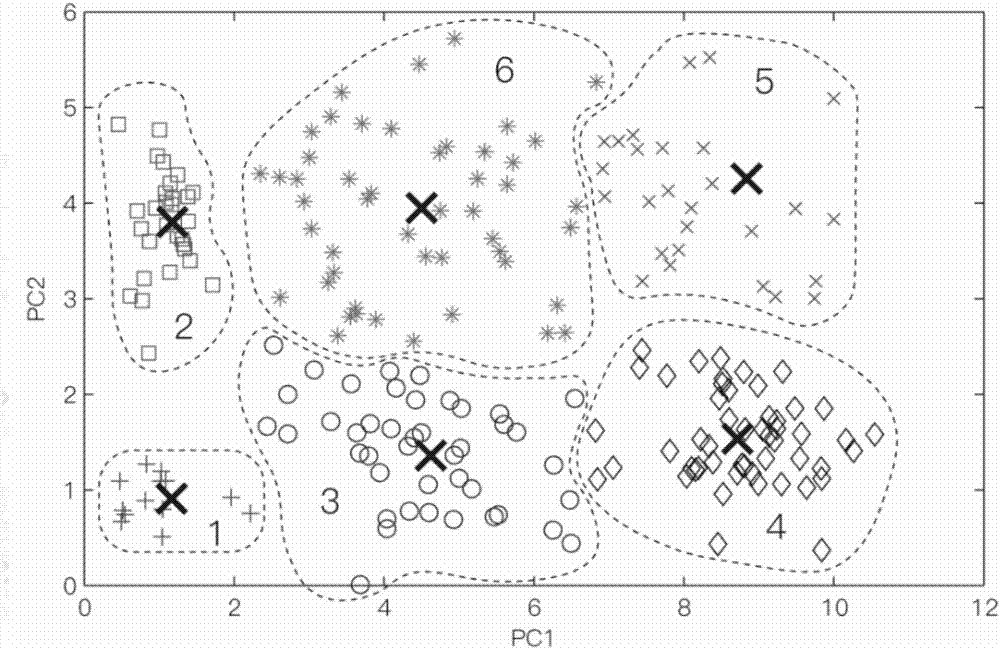Diabetes typing method and device
A typing method and diabetes technology, applied in special data processing applications, instruments, electrical digital data processing, etc., can solve problems such as standardization defects in promotion and typing
- Summary
- Abstract
- Description
- Claims
- Application Information
AI Technical Summary
Problems solved by technology
Method used
Image
Examples
Embodiment 1
[0085] Our test group is composed of 213 patients from a certain hospital who have been diagnosed with type 2 diabetes. 213 subjects did not have typical features of typical type 1 diabetes and other types of diabetes. The subjects had to fast overnight for 10h-12h, and take venous blood on an empty stomach in the morning of the next day, and measure fasting blood glucose (FG) and glycosylated hemoglobin (HbA1c) on the same day; take serum and store it in a -80°C refrigerator for unified Other indicators were detected, including fasting proinsulin (FPI), fasting insulin (FI), and fasting C-peptide (C-peptide). Unless otherwise specified, conventional equipment and methods are used, and the specific detection methods are as follows:
[0086] 1. The detection of blood glucose and glycosylated hemoglobin is completed by ADVIA2400 automatic biochemical analyzer;
[0087] 2. Serum insulin and proinsulin were detected by biotin-avidin double-antibody sandwich enzyme-linked immunos...
Embodiment 2
[0096] The K-means clustering algorithm is used to perform cluster analysis on 213 diabetic patients. The K-means clustering algorithm is a clustering algorithm that uses distance as a similarity evaluation index. If the distance between two objects is closer, the similarity is greater. Big. K-means clustering algorithm considers that clusters are composed of close objects, so compact and independent clusters will be obtained as the final goal. The K-means clustering algorithm has many advantages such as the calculation time complexity is close to linear, and is suitable for the mining of large-scale data sets. Therefore, the K-means clustering algorithm is adopted as a real situation to verify the scientificity of the diabetes typing method disclosed in the present invention.
[0097] Principal component analysis (PCA) is a statistical method that uses the idea of dimensionality reduction to convert multiple indicators into a few comprehensive indicators. Its function is t...
Embodiment 3
[0101] Adopt diabetes typing method of the present invention to carry out typing to 213 diabetic patients of embodiment 1, then carry out PCA analysis to typing result, carry out dimension reduction drawing by PCA, and represent different typing by different label symbols, can It is obvious that there are 6 major subgroups, such as image 3 shown. From image 3 It can be seen that the typing result of the present invention is very similar to the result of k-means clustering typing after PCA analysis after PCA analysis.
[0102] In order to calculate the similarity between the k-means clustering type and the diabetes typing method of the present invention, the coincidence degree is used for calculation, and the coincidence degree refers to the part where the distribution of the quality characteristic value and the distribution of the expected value coincide with the total quality characteristic value The ratio of the distribution. The coincidence degree between the diabetes ...
PUM
 Login to View More
Login to View More Abstract
Description
Claims
Application Information
 Login to View More
Login to View More - R&D
- Intellectual Property
- Life Sciences
- Materials
- Tech Scout
- Unparalleled Data Quality
- Higher Quality Content
- 60% Fewer Hallucinations
Browse by: Latest US Patents, China's latest patents, Technical Efficacy Thesaurus, Application Domain, Technology Topic, Popular Technical Reports.
© 2025 PatSnap. All rights reserved.Legal|Privacy policy|Modern Slavery Act Transparency Statement|Sitemap|About US| Contact US: help@patsnap.com



